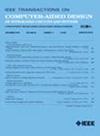随时间变化的现场测试与存储和计数器为基础的逻辑内置自检
IF 2.9
3区 计算机科学
Q2 COMPUTER SCIENCE, HARDWARE & ARCHITECTURE
IEEE Transactions on Computer-Aided Design of Integrated Circuits and Systems
Pub Date : 2025-01-28
DOI:10.1109/TCAD.2025.3536384
引用次数: 0
摘要
现场测试对于检测未通过制造测试或在芯片使用寿命期间发生的缺陷非常重要。当定期进行现场测试时,一些测试周期可能比其他测试周期短。较短的测试周期应侧重于最可能随着老化而发生的故障,而较长的测试周期则可以应用更全面的测试集。本文在逻辑内置自检(LBIST)方法的上下文中研究此场景,该方法将压缩测试划分为片上存储的子向量,并使用计数器将子向量组合为片上压缩测试。这种方法具有较低的存储需求,允许实现完整的故障覆盖,并且使用适度数量的测试。在短测试周期内应用少量测试的问题被表述为重新排列子向量(可能有重复和修改)的静态问题,以便第一个$n_{1}$子向量足以检测故障子集$F_{1}$,而$n_{1}$尽可能小。在学术环境下对基准电路的实验结果表明了测试的数量和总体存储需求。本文章由计算机程序翻译,如有差异,请以英文原文为准。
Varying Periods of In-Field Testing With Storage- and Counter-Based Logic Built-In Self-Test
In-field testing is important for detecting defects that escaped manufacturing tests or occurred during the lifetime of a chip. When in-field testing is performed periodically, some of the test periods may be shorter than others. Short test periods should focus on the faults that are the most likely to occur with aging, whereas long test periods can apply a more comprehensive test set. This article studies this scenario in the context of a logic built-in self-test (LBIST) approach that partitions compressed tests into subvectors for on-chip storage, and combines subvectors into compressed tests on-chip using counters. This approach has low storage requirements, allows complete fault coverage to be achieved, and uses a moderate number of tests. The problem of applying a small number of tests during a short testing period is formulated as a static problem of rearranging the subvectors (with possible repetitions and modification) such that the first $n_{1}$ subvectors are sufficient for detecting a subset of faults $F_{1}$ , and $n_{1}$ is as small as possible. Experimental results for benchmark circuits in an academic environment demonstrate the number of tests and overall storage requirements.
求助全文
通过发布文献求助,成功后即可免费获取论文全文。
去求助
来源期刊
CiteScore
5.60
自引率
13.80%
发文量
500
审稿时长
7 months
期刊介绍:
The purpose of this Transactions is to publish papers of interest to individuals in the area of computer-aided design of integrated circuits and systems composed of analog, digital, mixed-signal, optical, or microwave components. The aids include methods, models, algorithms, and man-machine interfaces for system-level, physical and logical design including: planning, synthesis, partitioning, modeling, simulation, layout, verification, testing, hardware-software co-design and documentation of integrated circuit and system designs of all complexities. Design tools and techniques for evaluating and designing integrated circuits and systems for metrics such as performance, power, reliability, testability, and security are a focus.

 求助内容:
求助内容: 应助结果提醒方式:
应助结果提醒方式:


